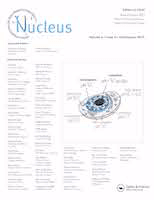
CURRENT OPINION IN CELL BIOLOGY
Scope & Guideline
Advancing Insights in Cellular Mechanisms
Introduction
Aims and Scopes
- Cytoskeletal Dynamics and Mechanics:
A core area of focus is the study of cytoskeletal structures, their dynamics, and their roles in cell shape, movement, and mechanotransduction. This includes insights into actin and microtubule behavior, as well as their interactions with cellular membranes. - Cellular Organization and Function:
The journal extensively covers the spatial and temporal organization of cellular components, including the nucleus, organelles, and cytoskeletal elements, emphasizing how these structures contribute to overall cellular function and dynamics. - Mechanobiology:
Mechanobiology is a significant theme, exploring how physical forces and mechanical properties of cells influence biological processes, including cell migration, differentiation, and signal transduction. - Genome Organization and Regulation:
Research on chromatin structure, gene regulation, and the interplay between nuclear architecture and function is a prominent area, highlighting advances in understanding how these processes impact cellular behavior. - Cell-Cell Interactions:
The journal also addresses the mechanisms of cell-cell communication and interactions, particularly in the context of development, tissue homeostasis, and disease, underlining the importance of these processes in multicellular organisms. - Technological Advances in Cell Biology:
CURRENT OPINION IN CELL BIOLOGY showcases innovative methodologies and technologies, such as advanced imaging techniques and computational modeling, that are revolutionizing the study of cellular processes.
Trending and Emerging
- Integration of Mechanobiology and Cell Function:
There is a growing emphasis on understanding how mechanical forces influence cellular functions, with studies focusing on mechanotransduction pathways and their implications in health and disease. - Advanced Imaging Techniques:
Recent publications highlight the use of cutting-edge imaging technologies, such as super-resolution microscopy and live-cell imaging, which are enabling researchers to visualize cellular processes in real-time with unprecedented detail. - Biomolecular Condensates and Phase Separation:
Research on biomolecular condensates and their role in cellular organization and signaling is rapidly gaining traction, reflecting a shift towards understanding the physical principles underlying cellular compartmentalization. - Interplay Between Genomic Architecture and Cellular Function:
Emerging studies are increasingly exploring the relationship between genome organization, chromatin dynamics, and their functional implications, particularly in the context of gene regulation and cellular responses. - Cellular Responses to Environmental Cues:
There is a notable trend towards investigating how cells sense and respond to their microenvironment, including mechanical and biochemical signals, which has significant implications for development and cancer biology. - Focus on Disease Mechanisms and Therapeutic Targets:
An increasing number of articles are addressing specific disease mechanisms, particularly in cancer and neurodegenerative diseases, with a focus on identifying potential therapeutic targets through a cellular lens.
Declining or Waning
- Traditional Biochemical Pathways:
There has been a noticeable decrease in discussions centered around classical biochemical pathways, as newer integrative approaches that combine biophysics and systems biology take precedence. - Static Models of Cellular Behavior:
Research focusing on static or simplified models of cellular behavior is waning, as the field increasingly embraces dynamic and complex models that better reflect in vivo conditions. - Generalized Cell Types and Functions:
There seems to be a diminishing focus on generalized studies of cell types, with more emphasis being placed on specific cell functions and their roles in disease contexts. - In Vitro Studies without Contextual Relevance:
The trend is moving away from purely in vitro studies that lack physiological relevance, as researchers are increasingly seeking to understand cellular processes in more realistic environments. - Focus on Single Molecule Studies:
While single molecule studies have been pivotal, there is a declining trend in their standalone significance as the field shifts toward collective behavior and multi-scale approaches.
Similar Journals

Cell Adhesion & Migration
Advancing Knowledge in Cell Biology and NeuroscienceCell Adhesion & Migration, published by Taylor & Francis Inc, is a premier open access journal that has been providing a platform for the dissemination of high-quality research since its inception in 2007. With an emphasis on the critical roles that cell adhesion and migration play in various biological processes, this journal endeavors to publish cutting-edge studies in cell biology and cellular and molecular neuroscience. The journal's strong impact is reflected in its classification in the Q2 quartile for both Cell Biology and Cellular and Molecular Neuroscience categories as of 2023, underscoring its significance in advancing knowledge within the scientific community. The journal is accessible globally due to its open access model established in 2019, making it a valuable resource for researchers, professionals, and students aiming to explore innovative findings in cell dynamics and their implications in health and disease. With a commitment to fostering collaboration and dialogue among scientists, Cell Adhesion & Migration continues to be an essential resource in the rapidly evolving fields of cell biology and neuroscience.

CELL STRUCTURE AND FUNCTION
Fostering Innovation in Cell Biology ResearchCELL STRUCTURE AND FUNCTION is a distinguished open-access journal published by the Japan Society for Cell Biology, dedicated to advancing the field of cell biology and related disciplines. Since its inception in 1975, and now with open access available since 2017, the journal seeks to disseminate cutting-edge research and reviews that delve into the complexities of cellular structures and their functions. With a notable presence in various categories—ranked Q3 in Cell Biology and Molecular Biology and Q2 in Medicine (Miscellaneous) and Physiology as of 2023—this journal caters to a global audience of researchers, professionals, and students who are keen to explore the latest findings in cellular research. The efforts to foster accessibility and promote scholarly exchange in the field make CELL STRUCTURE AND FUNCTION an essential resource for those looking to stay at the forefront of biological sciences. The journal is indexed in Scopus, marking its relevance and reliability in the academic community. Explore the vast potential of cell biology through this comprehensive platform.

Molecular Cell
Exploring the Nexus of Molecular and Cellular Biology.Molecular Cell, published by Cell Press, is a leading journal in the fields of cell biology and molecular biology. Established in 1997, this prestigious journal boasts a significant impact within the scientific community, evidenced by its impressive 2023 Scopus rankings, placing it in the top 2% of its field (Rank #10/410 in Molecular Biology, Rank #12/285 in Cell Biology). With a focus on cutting-edge research that bridges the gap between molecular genetics and cellular function, Molecular Cell serves as an essential platform for the dissemination of vital findings and innovative methodologies. Although it follows a traditional publishing model without Open Access options, its rigorous peer-review process and high standards ensure that articles published within these pages are of the utmost quality, making it an invaluable resource for researchers, professionals, and students alike seeking to stay at the forefront of scientific discovery. The journal's address is 50 Hampshire St, Floor 5, Cambridge, MA 02139, United States, reinforcing its commitment to fostering scientific excellence and collaboration.

Frontiers in Cell and Developmental Biology
Fostering collaboration for groundbreaking biological discoveries.Frontiers in Cell and Developmental Biology is a leading open-access journal published by FRONTIERS MEDIA SA, dedicated to advancing the understanding of fundamental biological processes at the cellular and developmental levels. Since its inception in 2013, the journal has positioned itself as a cornerstone of research in its field, achieving esteemed Q1 quartile rankings in both Cell Biology and Developmental Biology for 2023. With a robust Scopus ranking of #13 out of 82 in Developmental Biology and #67 out of 285 in Cell Biology, it represents a vital platform for innovative research and scholarly discourse. The journal provides a comprehensive and accessible avenue for researchers, professionals, and students alike to share high-quality findings and insights into cellular mechanisms and developmental processes, fostering collaboration and knowledge exchange in the global scientific community. Based in Lausanne, Switzerland, Frontiers in Cell and Developmental Biology is committed to open science, ensuring that all articles are freely accessible to the public, thereby broadening the impact of research in the biological sciences.

Nucleus
Advancing cellular understanding for a healthier tomorrow.Nucleus is a distinguished academic journal published by Taylor & Francis Inc, dedicated to advancing the fields of Cell Biology and Medicine. Since its inception, the journal has gained significant recognition, achieving a Q1 ranking in both Cell Biology and Medicine (miscellaneous) categories in 2023. With a focus on innovative research that intersects molecular biology and genetics, Nucleus serves as a vital platform for researchers and professionals aiming to disseminate findings that contribute to our understanding of cellular mechanisms and their implications in health and disease. The journal's commitment to Open Access since 2018 ensures that cutting-edge research is readily available to the global community, fostering collaboration and engagement across disciplines. Located in Philadelphia, PA, Nucleus not only aims to publish high-quality articles but also aspires to influence future research directions in the biological sciences, making it an essential resource for anyone involved in the life sciences.

Cell Systems
Connecting Researchers to Impactful Insights in Cell SystemsCell Systems is an esteemed journal published by CELL PRESS, dedicated to advancing the field of systems biology and its applications in cell biology, histology, and pathology. Since its inception in 2015, it has quickly ascended to a prominent position within the academic community, currently holding a Q1 ranking across multiple categories including Cell Biology, Histology, and Pathology and Forensic Medicine for 2023. With an impressive Scopus ranking—third in Medicine: Pathology and Forensic Medicine, and similarly high standing in Histology—it serves as a key resource for researchers and professionals aiming to explore and disseminate cutting-edge research findings. The journal provides an open-access platform, making it an accessible source of knowledge for students and scholars alike, fostering collaboration and innovation within the dynamic landscape of cellular research. With a commitment to high-quality and impactful publications, Cell Systems plays a pivotal role in shaping the future of biological sciences.

Annual Review of Cell and Developmental Biology
Exploring the Dynamics of Life at the Cellular LevelThe Annual Review of Cell and Developmental Biology, published by Annual Reviews, stands as a premier journal in the fields of cell biology and developmental biology. Established in 1995, this influential journal has continuously provided comprehensive and critical reviews that synthesize the latest findings in these vibrant research areas, catering to the interests of researchers, professionals, and students alike. With an impressive impact factor, the journal ranks in the top quartile (Q1) for both Cell Biology and Developmental Biology, boasting remarkable Scopus rankings—#1 in Developmental Biology and #22 in Cell Biology. This emphasizes its significance and authority within the academic community. Although the journal does not operate under an open-access model, it remains a crucial resource for those seeking to stay at the forefront of scientific discoveries and theoretical advancements. The Annual Review of Cell and Developmental Biology continues to solidify its status as an essential platform for sharing knowledge and stimulating scientific inquiry.

CELL RESEARCH
Unveiling the Mysteries of Cellular MechanismsCELL RESEARCH is a premier peer-reviewed journal dedicated to advancing the field of cell biology and molecular biology, published by SpringerNature. With an impressive impact factor and consistently ranking in the Q1 quartile for both cell biology and molecular biology, this journal serves as a pivotal resource for researchers, professionals, and students seeking to explore the latest discoveries and advancements in cellular mechanisms and their implications for health and disease. Since its inception in 1996, CELL RESEARCH has cultivated a distinguished reputation, currently boasting ranks in the top percentile of Scopus categories, reaffirming its influence and relevance to the scientific community. Although it is not an Open Access journal, its rigorous selection process ensures the publication of high-quality articles that contribute significantly to our understanding of life sciences. For those deeply engaged in the realms of biochemistry, genetics, and molecular biology, CELL RESEARCH is an essential conduit of innovative research and critical insights.

Cell Reports
Advancing the Frontiers of Molecular DiscoveryCell Reports is a prestigious open-access journal published by CELL PRESS that has firmly established itself as a leading voice in the fields of Biochemistry, Genetics, and Molecular Biology. Since its inception in 2012, the journal has provided an innovative platform for rapid dissemination of cutting-edge research, ensuring that high-quality findings are accessible to a global audience. With an impressive impact factor and ranking within the top 10% in its category, as reflected by its Q1 ranking in Scopus, Cell Reports serves a vital role in advancing scientific knowledge and fostering collaboration among researchers. The journal's commitment to the open-access model not only enhances visibility but also encourages the sharing of critical advancements in molecular biology. Situated in the Netherlands, its contributions are recognized worldwide, making Cell Reports an indispensable resource for scientists aiming to stay at the forefront of their fields and facilitate breakthroughs that may shape the future of biomedicine.

POSTEPY BIOLOGII KOMORKI
Illuminating Cellular Mysteries, One Study at a TimePOSTĘPY BIOLOGII KOMÓRKI is a pivotal journal in the field of cell biology, published by the renowned Polskie Towarzystwo Anatomiczne. Since its inception, this journal has been dedicated to advancing scientific knowledge through the dissemination of high-quality research articles, reviews, and original studies focused on cellular structure and function. Although POSTĘPY BIOLOGII KOMÓRKI does not currently operate as an open-access journal, it remains a significant resource for researchers and professionals alike, contributing to critical discussions and findings in the biological sciences. The journal has undergone coverage discontinuation in Scopus, yet it continues to serve as an essential platform in Poland for scholarly exchange in cellular and anatomical research. Situated at the Centrum Medyczne Kształcenia Podyplomowego in Warsaw, it aims to bridge gaps in understanding and nurture academic growth among students and professionals in the biological sciences.